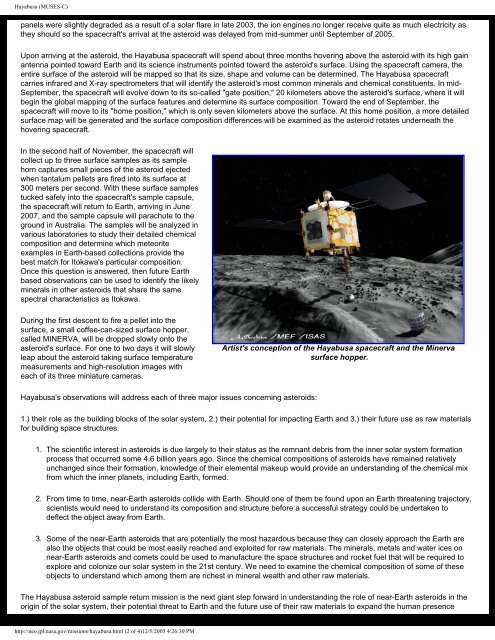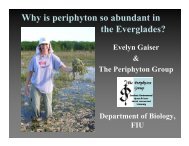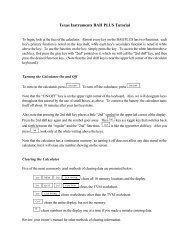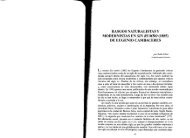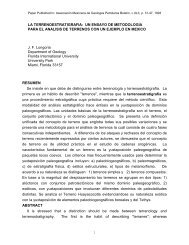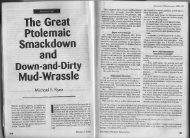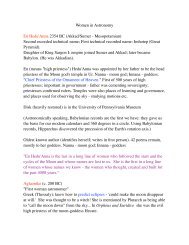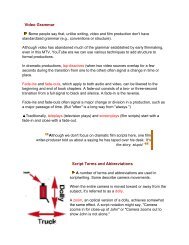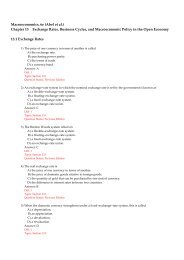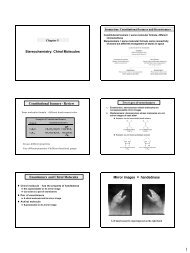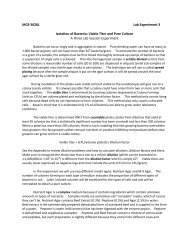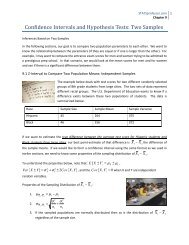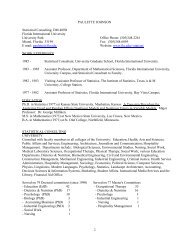Asteroid Comet Impact Hazards - Florida International University
Asteroid Comet Impact Hazards - Florida International University
Asteroid Comet Impact Hazards - Florida International University
You also want an ePaper? Increase the reach of your titles
YUMPU automatically turns print PDFs into web optimized ePapers that Google loves.
Hayabusa (MUSES-C)<br />
panels were slightly degraded as a result of a solar flare in late 2003, the ion engines no longer receive quite as much electricity as<br />
they should so the spacecraft's arrival at the asteroid was delayed from mid-summer until September of 2005.<br />
Upon arriving at the asteroid, the Hayabusa spacecraft will spend about three months hovering above the asteroid with its high gain<br />
antenna pointed toward Earth and its science instruments pointed toward the asteroid's surface. Using the spacecraft camera, the<br />
entire surface of the asteroid will be mapped so that its size, shape and volume can be determined. The Hayabusa spacecraft<br />
carries infrared and X-ray spectrometers that will identify the asteroid's most common minerals and chemical constituents. In mid-<br />
September, the spacecraft will evolve down to its so-called "gate position," 20 kilometers above the asteroid's surface, where it will<br />
begin the global mapping of the surface features and determine its surface composition. Toward the end of September, the<br />
spacecraft will move to its "home position," which is only seven kilometers above the surface. At this home position, a more detailed<br />
surface map will be generated and the surface composition differences will be examined as the asteroid rotates underneath the<br />
hovering spacecraft.<br />
In the second half of November, the spacecraft will<br />
collect up to three surface samples as its sample<br />
horn captures small pieces of the asteroid ejected<br />
when tantalum pellets are fired into its surface at<br />
300 meters per second. With these surface samples<br />
tucked safely into the spacecraft's sample capsule,<br />
the spacecraft will return to Earth, arriving in June<br />
2007, and the sample capsule will parachute to the<br />
ground in Australia. The samples will be analyzed in<br />
various laboratories to study their detailed chemical<br />
composition and determine which meteorite<br />
examples in Earth-based collections provide the<br />
best match for Itokawa's particular composition.<br />
Once this question is answered, then future Earth<br />
based observations can be used to identify the likely<br />
minerals in other asteroids that share the same<br />
spectral characteristics as Itokawa.<br />
During the first descent to fire a pellet into the<br />
surface, a small coffee-can-sized surface hopper,<br />
called MINERVA, will be dropped slowly onto the<br />
asteroid's surface. For one to two days it will slowly<br />
leap about the asteroid taking surface temperature<br />
measurements and high-resolution images with<br />
each of its three miniature cameras.<br />
Hayabusa's observations will address each of three major issues concerning asteroids:<br />
Artist's conception of the Hayabusa spacecraft and the Minerva<br />
surface hopper.<br />
1.) their role as the building blocks of the solar system, 2.) their potential for impacting Earth and 3.) their future use as raw materials<br />
for building space structures.<br />
1. The scientific interest in asteroids is due largely to their status as the remnant debris from the inner solar system formation<br />
process that occurred some 4.6 billion years ago. Since the chemical compositions of asteroids have remained relatively<br />
unchanged since their formation, knowledge of their elemental makeup would provide an understanding of the chemical mix<br />
from which the inner planets, including Earth, formed.<br />
2. From time to time, near-Earth asteroids collide with Earth. Should one of them be found upon an Earth threatening trajectory,<br />
scientists would need to understand its composition and structure before a successful strategy could be undertaken to<br />
deflect the object away from Earth.<br />
3. Some of the near-Earth asteroids that are potentially the most hazardous because they can closely approach the Earth are<br />
also the objects that could be most easily reached and exploited for raw materials. The minerals, metals and water ices on<br />
near-Earth asteroids and comets could be used to manufacture the space structures and rocket fuel that will be required to<br />
explore and colonize our solar system in the 21st century. We need to examine the chemical composition of some of these<br />
objects to understand which among them are richest in mineral wealth and other raw materials.<br />
The Hayabusa asteroid sample return mission is the next giant step forward in understanding the role of near-Earth asteroids in the<br />
origin of the solar system, their potential threat to Earth and the future use of their raw materials to expand the human presence<br />
http://neo.jpl.nasa.gov/missions/hayabusa.html (2 of 4)12/5/2005 4:26:30 PM


